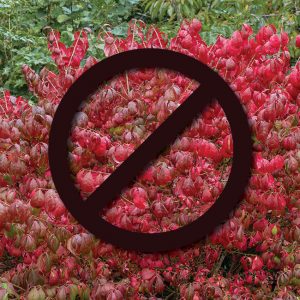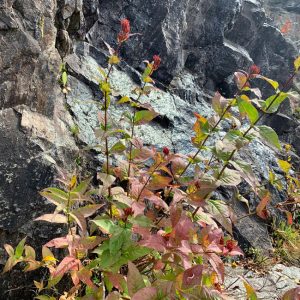 At our Nursery here in Franklin, NC, we have made a conscious decision to not sell Burning Bush (Euonymus alatus). Also Known as: “Winged Euonymus”, “Winged Burning Bush”, “Winged Spindle Tree” and is instantly recognizable in late fall as the “shrub with the fiery red leaves” that is planted all over town and in people’s yards.
At our Nursery here in Franklin, NC, we have made a conscious decision to not sell Burning Bush (Euonymus alatus). Also Known as: “Winged Euonymus”, “Winged Burning Bush”, “Winged Spindle Tree” and is instantly recognizable in late fall as the “shrub with the fiery red leaves” that is planted all over town and in people’s yards.
While being very striking this time of year, it is considered an exotic, invasive plant.
Exotic because it doesn’t live here naturally (it is native to forests, woodlands and scrub areas in eastern Russia, Japan, China and Korea).
Invasive because it spreads a whole lot of viable seed, which are widely dispersed by birds and other wildlife. The plants grow in and invade other areas where they are not desirable, including natural and wild forest areas where they then crowd out native species as dense thickets. They also have extremely dense and complex root systems.
Non-sustaining: As with many plants that did not evolve in our eco-region, none of our wildlife recognizes their leaves as a source of food. This means butterflies and moths won’t lay their eggs on their leaves, which would then provide safe haven and food for our future butterflies as well as food for our songbirds.
Poisonous Berries: Children may be attracted to their berries in the fall. No part of this plant is edible, including seeds: All parts are poisonous.
Already Got Burning Bush on Your Property?
First! Be careful to identify it is Euonymus alatus and not our native Euonymus americanus (Strawberry bush).
Manual, mechanical and chemical means are available to control established plantings. Seedlings can be pulled by hand. Shrubs can be repeatedly cut to the ground to control re-sprouts, or cut and treated with systemic herbicides like glyphosate and triclopyr. Don’t SPRAY! If you want to treat with a herbicide, brush the product on the cut stem so it doesn’t affect other plants or the soil.
Dispose of them in a way that prevents re-rooting. Learn more about control and identifying our native species in this PDF from Purdue Extension.
Native Alternatives:
Fortunately, there are some wonderful native alternatives.
Personally, I’m a huge fan of the Smooth Viburnum (Viburnum nudum) for its beautiful fall leaf color.
Another favorite native shrub for foliage (and seed pods) in fall is the Southern Bush Honeysuckle (Diervilla sessilifolia). Also a great support plant for our bumble bees.
I recommend you check out the following as well:
- Strawberry Bush / Euonymus americanus – showy red seed capsules in fall
- Highbush blueberry – Vaccinium corymbosum – Not just good for their fruit, also beautiful in fall
- Black Chokeberry / Aronia melanocarpa – berries are good for the birds AND for you
- Fragrant Sumac / Rhus aromatica – Great for a bank and known for her fall color
- Oakleaf Hydrangea / Hydrangea quercifolia – A crowd pleaser, beautiful blooms in spring and summer PLUS red/purple fall leaves
- Dwarf Fothergilla / Fothergilla gardenii – A great addition for a native pollinator garden
- Virginia Sweetspire / Itea virginica – Has spectacular spring flowers
- Spicebush / Lindera benzoin – Great wildlife value: host to Swallowtail butterflies with fruits for migrating songbirds
- American Smoketree / Cotinus obovatus – A beautiful covering of puffy smoke-like puffs in summer, one of the best fall colors
- Red Twig Dogwood / Cornus sericea or Cornus stolonifera – Excellent for a native pollinator garden, vibrant red stems in winterLike some more information on our stance regarding Burning Bush in NC? Just click!

